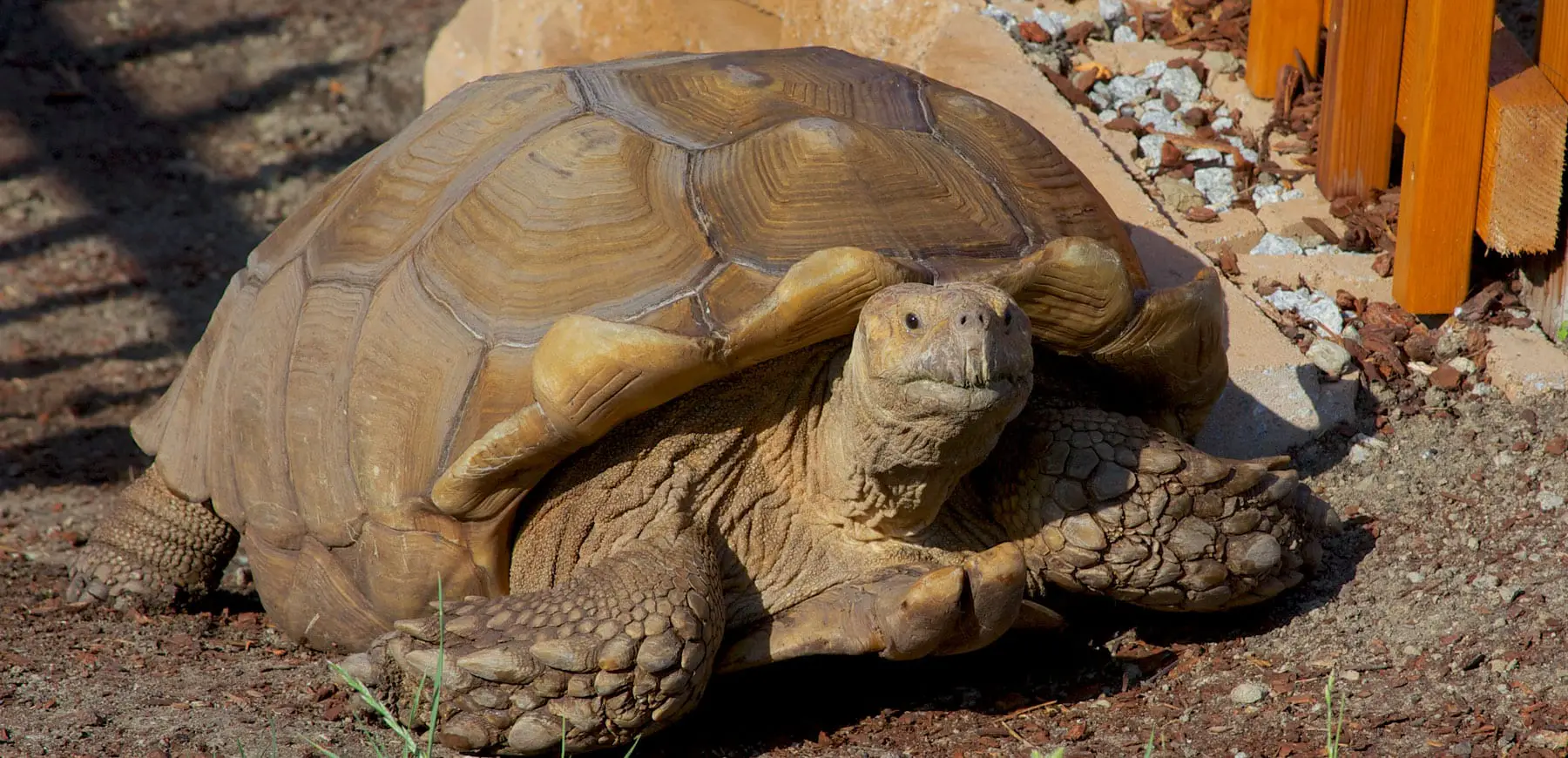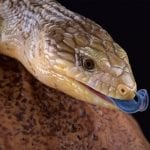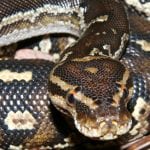Scientific Facts
| Common Names | Sulcata Tortoise, African Spurred Tortoise, Spurred Tortoise, African spurred, African Spur Thigh, Grooved Tortoise |
| Scientific Name | Centrochelys sulcata |
| Captive Lifespan | More than 20 Years |
| Size | 24+ inches |
| Mass | 100+ Ibs. |
| Habitat | Semiarid savannas, thorn shrublands, grasslands |
| Country of Origin | North Central Africa – the Sahara Desert and the Sahel |
Physical Description
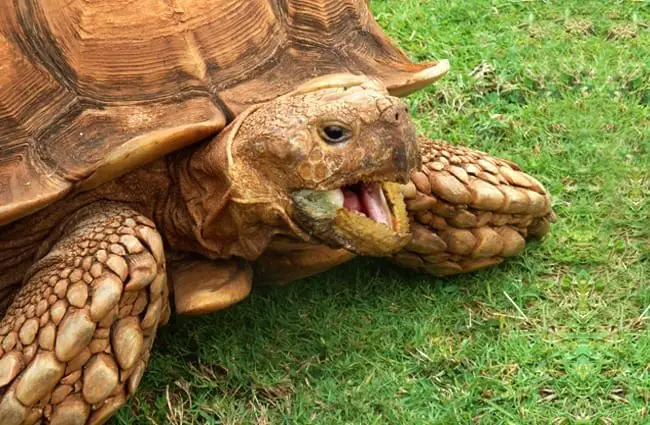
Formerly known as Geochelone sulcata, Centrochelys sulcata is the largest mainland tortoise species on the planet. The African spur is only surpassed in size by Galapagos tortoises, and the Aldabra giant tortoises, thus, ranked as the third-largest tortoise species in the world.
Sulcata tortoises can reach the impressive 24+ inches in length and can weigh over 100 Ibs. Usually, for Sulcata tortoises up to 5 years of age, the average mass is estimated at 40 Ibs.
The carapace of African Spurred Tortoises is serrated, and the anal scutes are split. Even though males are larger than females, females are characterized by wider openings.
These tortoises’ carapace ranges from pale brown to yellow in color and is rather wide and flat in shape. The moderately large head, as well as both of the limbs, are identical in color with the carapace. The legs of Sulcata tortoises are distinguishable by two or three strong spurs and thick scales.
The body coloration of hatchlings differs from that of adults, as baby African spurred tortoises’ scutes are narrow and bordered in brown, with distinct pale yellow carapaces.
Types
Being part of the family Testudinidae, genus Centrochelys, there are no subspecies of Centrochelys sulcata.
There is a visible difference in the physical appearance of the variant of the Sulcata tortoise found in Sudan, though, as it is described by being bigger overall, including the size of both the body and the shell.
Habitat & Lifespan
Sulcata tortoises are native to a transitional ecological region that consists of savannas, thorn shrublands, as well as grasslands, spanning across the countries of Chad, Mali, Somalia, Faso, Burkina, Senegal, Nigeria, Mauritania, Sudan, Ethiopia, and Eritrea.
With the preferred habitat for these amazing creatures being arid regions, where water is a very scarce resource, African spurred tortoises are known to burrow in the ground, so that they can reach zones with higher moisture levels.
It is in the burrows where spurred tortoises remain cozily hidden to spend the hottest parts of the day.
Even though it is still hard to firmly and accurately determine the average lifespan of African spurred turtles raised in captivity, as it has not been that long ago ever since these amazing reptiles were first captive-bred, most indications point out to these tortoises living for well over 20 years when kept as pets.
Also, when provided with dedicated care, low-stress environment, and proper, high-fiber, lean diet, these tortoises have been reported to live for over 70 years in captivity.
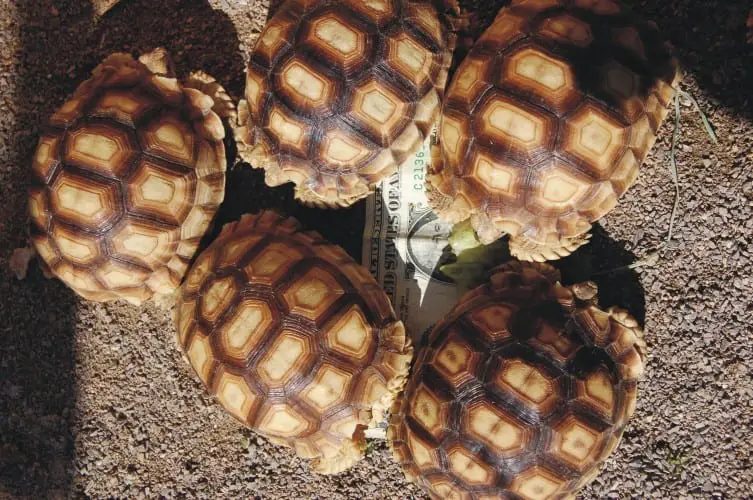
Behavior
Male Sulcata tortoises have earned a solid reputation for being quite aggressive towards each other. While vocalizing whistles, croaks, and grunts, males are to ram and bite each other.
In fact, ever since the very moment African spurred tortoises hatch, they are known to demonstrate aggressive behavior towards each other, and even trying to flip other hatchlings onto their shells.
During very hot or very cold weather, these tortoises become inactive. Thanks to burrowing themselves, they are capable of surviving long drought periods.
African Spurred Tortoises become most active during the rainy season, which lasts from July to October. In particular, they are known to become most active at dawn and dusk, as this is when they get to slowly wander, foraging for food.
In order to raise their body temperature, which inevitably drops during the cold nights in their natural habitat, Sulcata tortoises will spend the early hours of the day basking in the sun.
Caging
1. As a rule of thumb, outdoor enclosures are highly recommended for taking the best care of captive Sulcata tortoises. Depending on the caregiver’s area of residence and the associated weather patterns, it might be the case that the tortoise cannot be kept outdoors all year round. However, if the caregiver is to have access to an outdoor area, keeping African spurred tortoises outside for most of the year remains the most appropriate option, especially since these reptiles will grow quite large in size as they mature.
2. For housing Sulcata tortoises outside, keepers need to set up a desert-type of the enclosure, with a big grass area at the very center. Around the enclosure’s perimeter, it is strongly recommended to leave dirt and not grass, as African spurred tortoises are known to be “patrolling” around, destroying all of the existing grass over time.
3. In order to discourage tortoises kept outdoors from digging, a sturdy wall is a must. The wall should be at least 12 inches below ground, and at least 24 inches above the ground. For this purpose, concrete masonry block cemented in place will work great, and so will strong, well-made wood walls.
4. Do not use walls or fences that allow the tortoises to see through, as this encourages the animal to attempt escaping either over or through the walls/fences to explore the surroundings.
5. Provide a suitably-sized hide box. The hide box will serve as a warm refuge during cold weather, while simultaneously serving as a cool refuge whenever the temperatures are to rise in the spring/summer season. In the lack of a hide box, Sulcata tortoises will often burrow in seek of a retreat from the heat or cold.
6. If the tortoise’s digging is an issue, the caregiver can fill the localized spots with flagstones (make sure the flagstones are large enough, though). This should prevent the animal from digging in the future.
7. Note that if one is to take care of a single Sulcata tortoise, then it can be totally fine to allow the reptile to follow its instincts, and to burrow whenever desired.
However, when it comes to housing more than a single tortoise, allowing them to dig and burrow can lead to unwanted issues that can affect the creatures’ health and well-being adversely. When multiple tortoises are to share an outdoor enclosure, they often tend to get stacked up in their burrows, with the ones at the deepest end of the burrow being unable to safely exit.
8. An outdoor enclosure should be filled with various clump grasses. Also, African sumac trees and desert-type mesquite make a wonderful choice when it comes to decorating the cage and enhancing the aesthetic appeal. However, it is best to stay away from any fragile plants, since the tortoises are certainly to destroy them at some point in the future.
9. The caregiver’s safest bet when it comes to raising young Sulcata tortoises is to opt for an indoor enclosure. Even though these tortoises can do fair well anywhere, the temperatures are within the optimal range, keeping the young ones indoors during their first few years of life will best ensure their well-being.
10. For Sulcata tortoises up to 3 years of age, simple plastic sweater boxes will do great. Alternatively, caregivers can opt for a tortoise table. Mind that the size of the enclosure should not be your biggest concern with baby African spurs, but instead, the focus should be put onto furnishings and devices (think of lighting, substrate, temperature gradients) inside.
11. For Sulcata tortoises up to 1 year, an 18’’ x 18’’ x 12’’ enclosure will do fine.
12. For large Sulcata tortoises, caregivers who happen to live in cold climates can take the best advantage of building the enclosure in a garage or basement, where the tortoises can be kept warm and cozy during the cold months.
Substrate
1. Cypress mulch makes one of the best substrates for Sulcata tortoises of all sizes raised indoors, as cypress mulch is affordable, safe, and nonetheless, absorbent.
2. Coconut coir and peat moss do also make an excellent type of substrate. Also, various types of hays will work excellent, for instance, alfalfa, Bermuda, orchard grass, and timothy.
3. For the indoor enclosure, make sure the substrate for adult Sulcata tortoises is between 6 – 12 inches deep.
4. For outdoor enclosures, caregivers don’t really need any fancy substrates. Natural or mostly natural soil will work perfectly, as long as it is well-drained. Please, make sure the soil has not been treated with any toxic fertilizers or other chemicals that can harm the tortoise’s health!
5. If the soil in the caregiver’s backyard is not well-drained, which is the case with clay soils, as well as damp lawn grass terrains, simply dig out about 2 feet of the material, and after removing it, replace it with a layer of flat stones, followed by a layer of gravel, and finished with a layer of sandy soil.
Temperature, Lighting & Humidity
1. For Sulcata tortoises living outdoors, neither high nor low temperatures will be an issue, as these creatures are very tolerant of a wide range of temperatures. However, caregivers must ensure that the tortoises are provided with a shaded area to retreat as needed, as well as a heated hide box if the temperatures are to drop below 50 degrees Fahrenheit. Within the heated hide box, nighttime temperatures should be maintained between 55 and 70 degrees Fahrenheit (mind that keeping the temperatures in the 70 degrees Fahrenheit range is the safest bet).
2. As a rule of thumb, African spurred tortoises have been reported to perform great when raised outdoors all year round in areas where winter season nighttime lows do not get below 20 degrees Celsius, which is the case with Sulcata tortoises’ caregivers residing in Las Vegas.
3. It is imperative to check on the tortoises every night when temperatures are on the low end of the optimal rates (below 50 degrees Fahrenheit) since the animals must not be allowed to fall asleep outside, but instead, they must get into the heated hide box area.
4. For Sulcata tortoises’ caregivers raising these creatures indoors, maintain them at normal room temperatures between 68 – 80 degrees Fahrenheit. Also, provide a basking area by utilizing an overhead light and keeping the temperatures within the 100 degrees Fahrenheit range.
5. To help African spurred tortoises properly metabolize calcium derived from their diet, the indoor enclosure must be equipped with a suitable source of UVB light, such as linear reptile lights or compact fluorescent lights. Other suitable lighting systems can provide both heat and UVB light simultaneously.
6. For tortoises housed outdoors, supplemental UVB lighting is not necessary.
7. Keep lights ON for at least 12 and up to 14 hours a day, depending on the season.
8. Make sure to turn all heat and light sources at night.
9. Even though providing a humid area is not a must, since Sulcata tortoises come from a dry climate, and they are to burrow into the soil where it is moister, having a humid area at their disposal is highly recommended. For instance, tortoise caves lined with sphagnum moss will do a wonderful job for mimicking the humidity that the tortoises are to otherwise get by burrowing themselves
Diet
African spurs are herbivorous, and hence, their diet consists of various plants, with the bulk of their food consisting of roughage.
Eating Habits
Having a solid reputation as voracious grazers, Sulcata tortoises will rarely (if ever) turn down a meal, but instead, they will eagerly and gladly take the caregiver’s food offerings.
The best staple diet for adult African spurs should be made up of various leaves and grasses, just like their natural diets in the wild, such as mulberry leaves, lawn grasses, hibiscus leaves, and flowers, grape leaves, grass hays like orchard grass hay and timothy hay, clover, and the like.
Mind that baby, as well as smaller Sulcata tortoises, have significantly less powerful jaws than adults, and so they have a hard time when it comes to eating tougher, dried grasses, and hay. They will happily and easily feast on fresh grasses and greens, like kale, turnip tops, collard greens, and other dark green lettuce types, mixed with moistened tortoise diet food.
The key to establishing a proper diet for captive Sulcata tortoises is variety.
It is the caregiver’s responsibility to prevent the tortoise from eating rocks and/or soil. Never feed an African spurred tortoise directly from dirt or gravel but instead, offer food from a tray, on the concrete or flat rock, or on the grass surface.
Sleeping Habits
In their natural habitat, Sulcata tortoises do not hibernate, but instead, they aestivate. By excavating burrows in the ground, these beautiful creatures get access to areas where they can spend the hottest or coldest hours of the day or season, while also getting exposed to higher moisture levels.
African spurred tortoises are diurnal, and they spend the night peacefully sleeping.
Water
1. It is a good idea to provide a small, low-sided, shallow water dish. It is best to opt for glazed water dishes, as this type of water container makes cleaning very easy. When utilizing a water dish, do NOT use deep dishes, as Sulcata tortoises cannot swim.
2. Note that African spurs will soak, as well as defecate in their water dishes, so regular cleaning is a must. With this in mind, it is recommended that a water dish is provided during the hottest parts of the year. However, during cooler parts of the year, providing a water dish is only optional.
3. During the hot summer months, providing puddle areas and mud holes is also a wonderful move. Doing so will allow the tortoise/s to comfortably sit and cool themselves down without making much of a mess.
4. For Sulcata tortoises raised outdoors, it is good to know that they will drink straight from leaves and puddles, thanks to rainfall water getting collected. However, providing a water dish remains a must for caregivers residing in areas with prolonged periods of drought.
5. Note that many indoor Sulcata tortoises’ caregivers prefer not to give their pets any access to standing water, since these animals tend to immediately flush out their systems by defecating in their water dish at the very moment they begin drinking and/or soaking. Instead, the tortoises should be best soaked outside the enclosure once and up to twice weekly for 15 and up to 30 minutes in warm, shallow water. This will keep them perfectly well-hydrated.
6. Baby, as well as juvenile African spurs, should be soaked in warm, shallow water for 10 and up to 15 minutes between 2 and 3 times a week, regardless of whether they are housed outdoors or indoors. Young Sulcata tortoise is known to drink much quicker, as compared with mature, better-established tortoises, and hence the need for more frequent soaking in order to keep them well-hydrated.
Development and Reproduction
1. In their natural habitat, mating usually occurs from February to March, during the rainy season. Males are known to fight over females. Also, males are vocal during the course of mating.
2. Females gestate for a period of 2 months, and then they get to search for nesting places. Before the female chooses the best nest to lay the eggs, she is to make numerous nests.
3. Each of the African spur thighs’ nests takes from 1 and up to 4 hours to be made by the female, measuring up to 8 inches in depth and width.
4. Once the most suitable nest is chosen by the female, she starts laying eggs every three minutes.
5. One clutch consists of between 15 to over 30 eggs.
6. Once the eggs are laid, the nests are filled until the eggs are fully covered. The incubation period lasts for about 8 months. Hatchlings are to emerge within 1 – 3 days after rainfall, and they usually do so late at night.
7. Hatchlings need between 3 – 10 days before they manage to reach the nest’s surface.
8. At birth, hatchlings are as tiny as 2 – 3 inches and are colored in pale yellow. Within the first years of their lives, young African spurs are able to grow quite rapidly in size, reaching 6 – 10 inches on average.
9. Similar to other tortoises, Sulcata tortoises are capable of reaching a great age, and some can grow as old as 80 – 100 years of age, even though the oldest known species recorded is known to have reached 56 years.
How to Breed
In order for captive African spurs to breed, they should be provided the opportunity to make a nest by kicking out loose soil from the depression.
Usually, it takes females several excavating attempts (about 4 – 5) before they choose the most appropriate nest to lay their eggs. The speed with which a nest is dug depends on the relative hardness of the ground/soil.
To make the nest and then lay their eggs, Sulcata tortoises are known to require an ambient air temperature of at least 78 degrees Celsius.
The female should be allowed to fill in the nest, which typically takes about an hour or so.
Incubation will take anything from 90 to 120 days, with the eggs being maintained at 86 – 88 degrees Fahrenheit.
Handling
1. As a general rule of thumb, do not handle a Sulcata tortoise with any regularity. No matter how hardy and friendly these creatures are, frequent handling, and especially if being over-handled, will lead to high levels of stress, and stress will affect the reptile’s well-being, health, activity levels, and longevity adversely.
2. Do not leave minors alone with African spurs, as children often tend to drop the tortoises when spooked, potentially causing them stress, and even injuries in some cases.
3. As Sulcata tortoises mature, they are known to become more resistant to handling. However, caregivers are still highly encouraged to only handle adult African spur thighs very carefully.
4. Do not pin the tortoises down, and do not restrict them during handling. Instead, simply allow them to carry on their intended way freely. That’s especially important when it comes to young Centrochelys sulcata species.
5. With age and proper care, older African spurred turtles will usually get pretty well-used to people, and hence, more tolerant of handling without getting stressed.
How to Treat and Prevent Possible Health Issues
1. Not providing enough fiber into the diet of captive Sulcata tortoises is one of the most common dietary problems. Fortunately, it can be easily avoided by establishing a proper diet regimen.
2. Mustard greens, cauliflower, spinach, broccoli, and kale are very high in oxalic acids and can affect the tortoises’ health if provided in large amounts. Because of this, caregivers should avoid feeding their pets with any of the veggies listed above on a regular basis, but instead, these should be only used as occasional treats.
3. Fruits should also only be used as occasional treats, because of being rather high in both sugar and water. Caregivers can offer a bit of tomato, strawberry, or melon, among other fruits, as a lure when they want to wheedle their tortoise to move into the desired direction.
4. Respiratory infections can occur due to the environment of an African spur tortoise being too cold and/or too humid. Despite having a solid reputation for being hardy animals, Sulcata tortoises should not be allowed to get too cold, and they need to be able to dry out, without being exposed to damp substrate.
Drastic changes in temperatures can be easily avoided by using appropriate thermometers, as well as checking up on the turtles, especially when it comes to those housed in outdoor enclosures. Not the least, indoor enclosures’ heat bulbs should be also checked regularly, as they may burn out, causing the temperatures to drop below the recommended rates.
5. Only purchase an African spur from a reputable source, so that you can be provided with a guarantee of the reptile’s health status upon arrival. A healthy tortoise will be active and alert, with clean, bright eyes.
6. In the absence of UVB lighting, Sulcata tortoises raised indoors will develop serious health problems, such as abnormal shell growth, among other possible deformations.
7. By providing a humid hide, African spurs can be prevented from shell pyramiding, according to new studies.
Possible Dangers to Humans
As other reptiles and amphibians alike, Sulcata tortoise can possibly convey Salmonella bacteria to humans. Although Salmonella-related issues occur very rarely, they can be prevented by the caregiver, provided he/she is to simply keep strict hygiene at all times by always washing hands thoroughly after getting in contact with the tortoise itself, or with its feces.
Availability: How to Get an African Spurred Tortoise?
Only obtain an African spurred tortoise from reputable, reliable, trustworthy vendors, who can provide a guarantee for the tortoise’s origin and health status.
Fun Facts
1. “Sulcata” is a word of Latin origin. Translated from the Latin word “sulcus,” the common name for these tortoises means “furrow,” referring to the furrows on the reptile’s scales.
2. The burrows of African spurs can reach 30 inches in depth. In fact, some are known to dig tunnel systems that extend for over 10 feet underground. Most importantly, these tortoises thrive in perfect harmony with the living nature, as various succulents and grasses are known to grow around their burrows because of the soil being continuously replenished by the tortoises’ feces. Ultimately, these plants keep growing, fully available for the tortoises to feast on.
3. Just before it rains, Sulcata tortoises are known to exhibit quite a curious behavior, as they will get excited and start running around.
4. Female African spurs can raise their shells up off the ground, and afterward, they are to drop it with a thud.
5. In Senegal, Sulcata tortoises symbolize happiness, fertility, longevity, and virtue. Thanks to this, the much-needed conservation programs have been easier to successfully promote in Senegal.
6. To restrict water loss as much as possible, African spur thighs have very thick skin.
7. In the sandy environment in their natural habitat, the light tan to brown colored top shell gives ample camouflage.
8. Apart from spending the hottest parts of the day in their burrows, Sulcata tortoises are known to construct and share permanent sleeping burrows, where two or more tortoises can be found.
9. The growth rates of African spurs are considered some of the most variable among tortoises. A 3 years old Sulcata can easily reach 10 inches in size, yet a 10 years old Sulcata can also be 10 inches in size.
10. With their dinosaur-like snouts and pigeon-toad walks, Sulcata tortoises have become some of the most favorite pets in the USA, with celebrities like Colin Kaepernick and Leonardo DiCaprio also being proud African spurred tortoises owners.
How to Take Care of a Sulcata Tortoise?
1. Although this should go without saying, it is a must that any natural plants or grass that come in contact with a Sulcata tortoise will not have been treated with chemicals, such as pesticides, herbicides, and fertilizers.
2. For baby Sulcatas raised indoors, it is best to provide access to a humid hiding area. The babies will benefit from this area in order to get a healthy dose of humidity and a little bit of snuggling, just like they will do in a burrow in the wild. Thanks to the humid microclimate within the hidden area, the babies will be kept well-hydrated at all times, and their shells will grow smoothly, especially since they are known to dehydrate fairly quickly, forming bumpy shells as a result.
3. Caregivers are strongly encouraged to include a few flat, large rocks in indoor enclosures. Sulcatas will use the rocks the file down their nails. Also, rocks can be utilized as a clean, safe surface for food.
4. Only keep Sulcatas outside provided they have a suitable housing shed, such as a heated doghouse, which can be used during wet weather, as well as at night.
5. For indoor and outdoor enclosures alike, it is a great idea to add plants, rocks, and various other structures that will allow the reptile pet to hide behind, thus, keeping the animal’s interest.
FAQ Section
How to Take Care of a Sulcata Tortoise?
To take care of a Sulcata tortoise, establish an appropriate outdoor or indoor enclosure, making sure to maintain the temperature within the optimal rates. Limit fruits to only occasional treats, and lightly dust greens with good-quality calcium powder twice weekly.
How Often Do You Need to Feed Sulcata Tortoises?
As a rule of thumb, Sulcata tortoise should be provided with a low-protein, high-fiber diet consisting mainly of grass. Hay should be available for these tortoises to graze at all times. Usually, they will eat a pile of greens daily, with the pile being about the size of the tortoise itself.
Do Sulcata Tortoises Need Light at Night?
No, Sulcata tortoises do not need light at night. Therefore, all lights should be switched OFF for 12 hours, as these reptiles require darkness to fully rest. A ceramic night bulb can be utilized for maintaining nighttime temperatures within the 70 degrees Fahrenheit range for indoor enclosures, while outdoor enclosures should be provided a heated hide box where temperatures should be kept within the 60s – 70s degrees Fahrenheit range.
Do African Spurred Tortoises Need Water?
As African spurred tortoises come from a very dry and hot climate, they are fairly well adapted to living with very little water. They will get most of the water they need from their diet, yet weekly soaking in shallow water is a must to keep them well-hydrated. Also, a shallow water dish can be provided, although this is only optional, especially when it comes to indoor enclosures.
Do Sulcata Tortoises Eat Fruit?
Yes, Sulcata tortoises eat fruits, but these should be only given occasionally and in moderation. Apart from fibrous grasses making up for the majority of their diet, melon, berries, strawberries, bananas, and apples can be offered every now and then.
Can African Spurred Tortoises Eat Vegetables?
Yes, African spurred tortoises can eat vegetables. However, much like with fruits, vegetables should be only provided in moderation, and should ideally make up for no more than 10% – 15% of a healthy, varied diet. A list of veggies to feed African spurs with include raw red and green sweet peppers, cucumbers, zucchini, winter squash, grated carrots, pumpkin, broccoli, corn on the cob, sweet potatoes, as well as various greens, such as dandelions, romaine, kale, collards, and escarole.
What Temperature Do Sulcata Tortoises Require?
When housed indoors, Sulcata tortoises will thrive at normal room temperatures maintained within the 68 – 80 degrees Fahrenheit range. In the basking area, temperatures should be kept in the 100 degrees Fahrenheit range.
How Long Can Sulcata Tortoises Go without Food and Water?
In the wild, Sulcata tortoises can go without food and/or water for weeks. As soon as they find a water source after an extended period of drought, they can drink up to 15% of their body weight in order to get themselves well-hydrated.
What is the Best Bedding for Sulcata Tortoises?
One of the best types of bedding for Sulcata tortoises raised in captivity indoors, regardless of their size, is none other but cypress mulch bedding. For outdoor enclosures, organic, well-drained soil can work great.
How to Tell the Difference between Male and Female African Spurred Tortoises?
You can tell the difference between a male and a female African spur by taking a look at the bottom shell. Mature male African spurred tortoises’ bottom shells are concave, as this shape assists the breeding act. The plastrons of female African spurred tortoises are slightly convex or fully flat.
Are Sulcata Tortoises Aggressive?
Female and male Sulcata tortoises alike can be very aggressive, but that’s only limited among tortoises themselves, and majorly among males, as these tortoises are typically not to show aggression towards humans. These strong reptiles can break down fences and walls, being very active while climbing and roaming about.
Can You Cohabitate African Spurred Tortoises?
Being quite peaceful creatures, African spurred turtles can be cohabitated quite successfully when housed together in small groups. However, as males are especially territorial, cohabitating more than one single male in group enclosures should be avoided.
Do African Spurred Tortoises Make Good Pets?
If the caregiver can provide African spurred tortoises with the space needed to properly accommodate the large size they reach as adults, they can make great pets, as they are very social and docile. Getting a Sulcata tortoise pet is a long-term commitment, though, so it should be carefully planned to ensure the well-being of the reptile. African spurred tortoises are very friendly, fun, and curious to watch, and they can learn to recognize their caregiver and come to him/her for food, as well as some gentle head rubbing every now and then.
Are Sulcata Tortoises Solitary?
With or without a buddy to share their enclosure, Sulcata tortoises will be perfectly happy. Similar to other tortoises, Sulcatas tend to be quite solitary. Mind that you should only house tortoises of the same species together if you are determined to allow them to enjoy some company.

